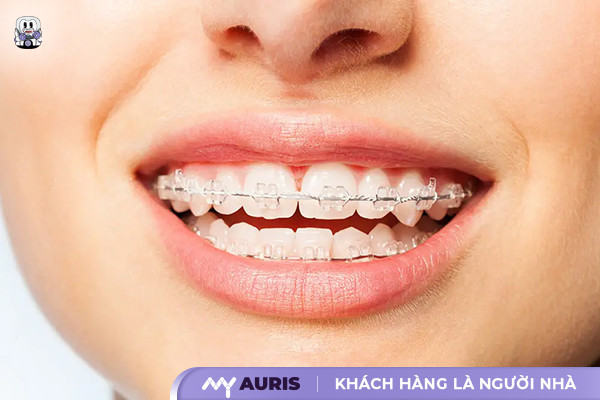Currently, orthodontic methods are receiving increasing attention in the field of oral health care, especially ceramic braces – a modern option with high aesthetic appeal. With a sophisticated design, ceramic brackets have a color close to natural teeth, helping patients feel more confident when communicating while still ensuring effective orthodontic treatment. This is considered a breakthrough in modern dental techniques, not only improving smiles but also contributing to enhancing the quality of life. The advent of ceramic brackets is a testament to the trend of combining technology and aesthetics in oral treatment.
How much do ceramic braces cost?
Ceramic braces are an aesthetic orthodontic method favored by many today due to their cosmetic advantages. Unlike traditional metal braces, ceramic brackets are designed from a bright white material that matches tooth color, allowing them to be almost “invisible” when attached to the front surface of the teeth. Along with the orthodontic archwire, this method still ensures effective orthodontic correction without affecting appearance.
Compared to metal braces, the cost of ceramic braces is often higher due to their superior aesthetics and body-safe material. Currently, the price of ceramic braces ranges from 40,000,000vnđ – 50,000,000vnđ per treatment. However, the specific fee may vary depending on each individual case.
This variation stems from the different dental misalignments in each person, including: gaps between teeth, buck teeth, protrusion, underbite, crowded teeth, etc. For cases with significant dental misalignment, the orthodontic treatment process is more complex and may require additional treatment methods such as tooth extraction or supporting mini-screws. In such cases, the dentist will need to calculate the tooth-pulling force and develop appropriate orthodontic stages to achieve optimal results and ensure patient safety throughout the treatment process.

Classification of Ceramic Braces
Currently, ceramic braces are divided into two main categories: conventional ceramic braces and self-ligating ceramic braces. Both are highly regarded for their aesthetics and effectiveness in tooth alignment, but each type has its own distinct characteristics and pros and cons, suiting the needs of different individuals.
Conventional Ceramic Braces
Based on the principle of traditional braces, this method uses elastic ligatures to secure the archwire, preventing it from moving and reducing friction with the teeth. The pulling force from the archwire helps move teeth into the desired position, providing optimal orthodontic results.
However, a disadvantage of this type is its lack of elasticity and low durability, which can lead to bracket detachment during treatment – affecting treatment duration and patient comfort.

Self-ligating Ceramic Braces
Self-ligating ceramic braces are designed with self-closing clips that secure the archwire instead of elastic ligatures. This allows the archwire to slide freely along the dental arch, helping to minimize pain and discomfort during treatment. Furthermore, this system also limits bracket detachment, effectively addressing bracket breakage, and is more convenient to clean.
Self-ligating ceramic braces are divided into 2 main types:
- Self-ligating ceramic braces with metal archwire: Uses a metal archwire with high stiffness and durability, providing strong tightening force. However, this type of wire can be aesthetically unpleasing as it is visible during communication, making it unsuitable for those who prioritize high aesthetics.
- Ceramic braces with transparent archwire: Uses a transparent nickel archwire, offering an optimal aesthetic solution, making it almost invisible during communication, suitable for those who frequently work or interact with clients.

Important things to know when getting ceramic braces
Who is suitable for ceramic braces?
Ceramic braces are particularly suitable for individuals with dental conditions such as: crooked teeth, spaced teeth, buck teeth, underbite, or malocclusion. Additionally, jaw-related issues like skewed jaw, narrow jaw, or misaligned jaw can also be effectively improved.
A prominent advantage is the aesthetic aspect of these braces, making them ideal for people who communicate frequently, providing confidence even during the treatment process.
Common Types of Ceramic Brackets
Currently, there are two main types of ceramic brackets used in treatment:
Conventional Ceramic Brackets
This is the conventional type of ceramic bracket, operating on a mechanism similar to metal braces, using elastic bands to hold the archwire, thereby creating frictional force to move the teeth.
However, a weakness of this type is its lack of elasticity, low stability, and tendency to detach easily if not carefully maintained.
Self-ligating Ceramic Brackets
Self-ligating ceramic brackets are an improved version, overcoming the limitations of conventional types. An automatic clip system is used to replace elastic bands, providing better archwire retention and allowing it to slide automatically along the entire dental arch.
Advantages include: maximum pain reduction, easy cleaning, quick adjustments, and reduced risk of bracket detachment during treatment.
Accompanying archwire types:
Metal archwire: High durability and stiffness, providing strong force for tooth correction, but its disadvantage is being clearly visible on the teeth, which can reduce user confidence and affect overall aesthetics.
Transparent nickel archwire: An optimal solution for those concerned with aesthetics. With a white color similar to teeth, the wire is almost invisible, making the braces nearly undetectable to others.

Duration of Ceramic Braces Treatment
The treatment duration for ceramic braces typically ranges from 18 to 24 months, depending on the patient’s oral condition, age, and the clinic’s technique. Some complex cases may require up to 36 months to achieve optimal results.
To shorten the bracing period, proper oral hygiene is the most crucial factor:
Diet: Prioritize soft, easy-to-chew foods to minimize tooth sensitivity and prevent bracket detachment. Additionally, limit cavity-causing foods such as sugary items and carbonated drinks to maintain healthy teeth.
Oral care and hygiene: Poor brushing can lead to loose, detached, or broken brackets, affecting the entire treatment process. If brushing is not thorough, food debris can easily accumulate, creating conditions for oral diseases to develop.





